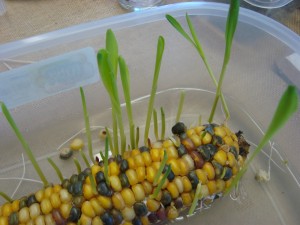The sound of rustling leaves, the smell of smoke from the fireplaces and the sight of leaves changing color are hallmarks of autumn. Without ears of Indian corn embellishing the décor in homes and businesses, the fall harvest season wouldn’t be complete.
From wreaths to centerpieces, Harvest Corn seems to be everywhere in October and November. Everywhere – except on a dinner plate! It’s corn; but can you actually eat it? Where did it come from? And can we grow our own harvest corn at home?
According to folklore, these colourful ears were named after the indigenous people of North America. They’d been cultivating it for years when they introduced it to the Europeans who arrived in the Western Hemisphere in the 15th century. But “Indian corn” isn’t exclusive to the North American continent. Experts say that it grew in China, India and South America for centuries; and our ancestors didn’t decorate with it, they ate it!
So, how can we sprout our own ear of Harvest corn? Simple! Follow the directions below and in a week you will have your very own baby corn plants!
Materials:
- 1 piece of Harvest Corn
- a pan or bucket you can set aside for a week or two (eg. A pyrex dish)
- water
- Break off or remove any remaining husk on your ear of corn and place it in your dish.
- Fill the pan with enough water to cover a little more than half the ear of corn.
- Place your pan in a sunny window.
- As the days go by, your water will begin to evaporate. You will need to periodically add more water so that half the ear of corn stays covered.
- By the time 4-5 days have passed, you should see little shoots popping out of your ear of corn.
- If you keep the ear of corn any longer than 5-6 days you may want to change out the water completely. Just make sure to put the ear of corn back in the pan with the sprouts up!
Why does this work? A kernel of corn is a seed and an ear of corn is a bunch of seeds packed together. When a seed is placed in water and sunlight (the correct environmental conditions) the seeds start to sprout. You can see the same thing happening when a bean is placed in a damp environment; every seed has the potential to become a plant if placed in the correct environmental conditions!
Questions to ask your child:
1. What is inside the kernel? (small plant)
2. Why do you think it needs a hard shell? (protection)
3. How Do the kernels get the water? (Small holes in the bottom of the kernel)
4. What would happen if the kernel couldn’t get the water or the sun? (It would not sprout)
5. Where do you see evidence of this activity outside? (seeds blowing in the wind etc.)
For more great things to discover – visit the Discovery Centre on Barrington Street in Halifax, check out their website or join them on facebook.



